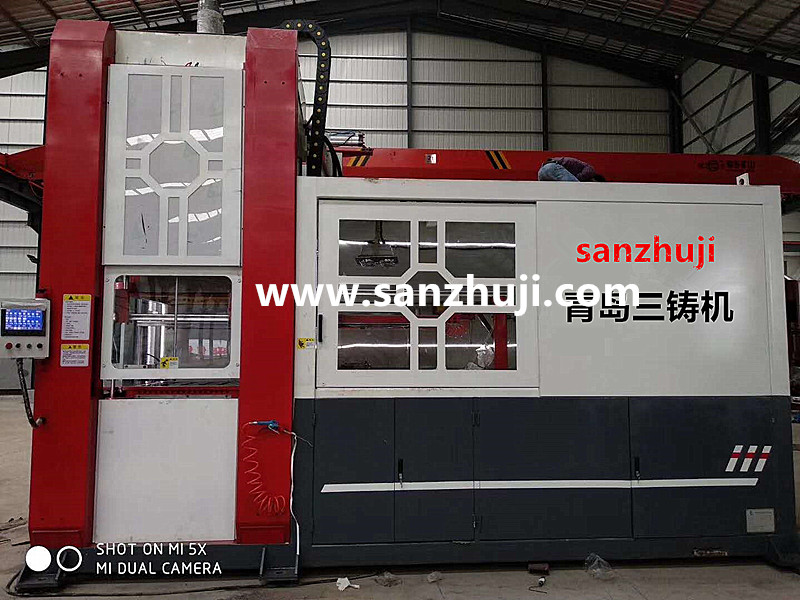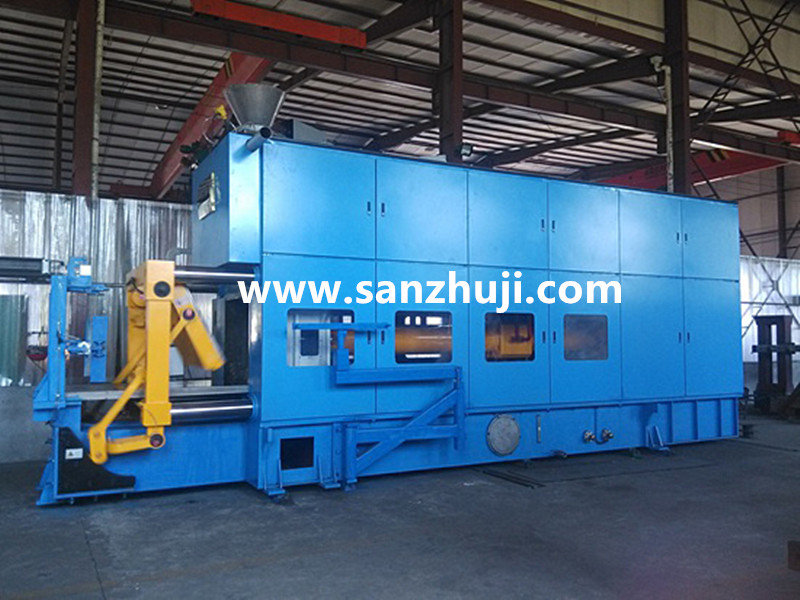1. Sand mixing process standard
Material requirements:
1.11 Modeling sand: Sanzhuji recommends choosing fine-grained sand that meets GB9442-88, JB435-63, natural sand or quartz sand with a high content of silica. The size of the original sand is determined by the size and wall thickness of the casting, and the mud content of the original sand The fraction should be less than 2%, the moisture in the raw sand must be strictly controlled, and generally it should be dried.
1.12 Water glass: The water glass mold should be determined according to the size of the casting.
1.13 Small sand mold (core) adopts high modulus water glass with M=2.7-3.2 for accelerated hardening.
1.14 Medium sand mold (core) can choose water glass with M=2.3-2.6.
1.15 For large sand molds (cores) with long production cycles, use low modulus water glass with M=2.0-2.2.
1.2 Mixing ratio (mass fraction%)
Modeling sand/water glass=100: 6~8
1.3 Mixing time: Under normal circumstances, the mixing time is 5 minutes, and the sand mixing time can be appropriately extended at room temperature or when the water glass density is high.
1.4 Requirements after mixing: The well-mixed modeling sand shall be free of lumps or lumps and have good fluidity
2. Key points of modeling process:
2.1 Basic principles:
2.11 The surface with high quality requirements or the main processing surface should be placed below.
2.12 The large plane should be placed below.
2.13 The thin-walled part should be placed below.
2.14 The thick part should be placed on top.
2.15 The number of sand cores should be minimized.
2.16 Try to use a flat parting surface.
2.2 Basic requirements:
2.21 Wooden mold: It is required to have a complete outline, no cracks, no damage, no incompleteness, smooth surface, and the size meets the requirements of the casting process drawing, and the size is checked frequently.
2.22 Sand box: The size of the sand box should be determined according to the specifications of the wooden mold. Large and medium-sized sand boxes should be welded with box ribs.
2.23 Pouring system: According to the process requirements of the structural characteristics of the casting, select a suitable pouring system, usually top injection and bottom injection.
2.231 Basic principles of pouring system setting: reasonable placement of gates and risers, suitable size does not hinder casting shrinkage, easy to exhaust, sand falling and cleaning, mold size should be minimized, simplification of molding operations, saving sand consumption and reducing labor strength.
2.232 Precautions for the position of the runner.
2.2321 Inner runner should not be located in important parts of the casting.
2.2322 The distance from which molten metal flows to each part of the cavity should be the shortest.
2.2323 The molten metal should not impact the mold and sand core from the front.
2.2324 The molten metal should be evenly dispersed and fill the cavity quickly.
2.2325 Do not face the cold iron and core support in the mold.
2.3 riser
2.31 Basic principles of riser setting:
2.311 Correctly select the shape, size and placement of the riser according to the structure and process requirements of the casting.
2.312 The number of risers is reasonably determined according to the effective feed range of the risers.
2.32 Basic requirements for riser setting:
2.321 For castings with uneven wall thickness, a riser must be provided at each hot spot.
2.322 should be installed as far as possible on the top or near the feeding part of the casting.
2.323 When the casting has hot joints at different heights and needs to be fed, multiple risers can be set, but the 2.324 feeder of each riser''''''''''''''''s feeding area is best not to be set in the important part of the casting or where the force is larger.
2.325 should try to make the inner runner pass the riser.
2.326 The riser should try not to be set at the stress concentration of the casting.
2.327 The riser is best set on the surface of the casting that needs to be machined.
2.4 Modeling operation:
2.41 Operation process
The sequence is: select the appropriate sand box→place the wooden mold→fill sand→compact→place the upper sand box→place the pouring riser→fill the sand→compact→remove the mold→harden
2.42 Operation methods and quality standards
2.421 According to the shape and size of the casting model, select a suitable sand box.
2.422 Put the casting model in the appropriate position in the sand box.
2.423 Add appropriate modeling sand to the sand box, use tools to compact the modeling sand in the sand box, and the degree of compaction should be moderate.
2.424 Use a scraper to scrape the modeling sand that is higher than the sand box to make the surface of the sand mold flush with the edge of the sand box.
2.425 Clean the floating sand on the surface of the model with a brush, cover the plastic film and make the film flat.
2.426 Place the upper sand box, the mouth of the upper and lower sand boxes should be aligned.
2.427 Place a pouring riser at a suitable position in the upper sand box, add modeling sand and compact it.
2.428 is divided into boxes to draw out the mold, repair the shape and harden the eye.
2.5 Sand mold cavity quality requirements
2.51 sand mold has no flash, no burr, no incompleteness, and the cavity is clean and free of sand and other foreign objects.
2.52 The cavity should be dry with a high degree of hardening, and it must be fully dried before closing the box (the hardening and baking time can be appropriately extended in winter).
The contour of the 2.53 sand mold is complete and clear, and the seal or mark on the box is complete and clear.
2.54 The gate and riser positions are set reasonably and the size meets the requirements; the exhaust hole is unobstructed, and the pouring system is set reasonably according to the casting.
2.6 Close the box
Combination is the process of combining sand molds and sand cores as required to form a casting mold. Traditionally, it is also called LCL, matching or deduction.
The packing work is generally carried out according to the following steps:
2.61 Comprehensive inspection, cleaning (sweeping, and repair of all sand molds and sand cores). Special attention should be paid to checking the drying degree of the sand cores and whether the air passages are unobstructed. Those who do not meet the requirements should be repaired or discarded.
2.62 Put the sand cores into the sand molds according to the order of the cores, and strictly inspect and ensure the wall thickness of the castings, the sand cores are fixed, the cores are exhausted and the gaps at the joints are filled.
2.63 Carefully remove the loose sand in the mold, comprehensively check the quality of the core, put a circle of mud sticks or asbestos rope along the periphery of the cavity on the parting surface to ensure that the parting surface is tightly closed after the box is combined and avoid liquid metal from the parting The surface gap flows out. The box can then be officially closed.
2.64 Put on the weight or fix the mold with bolts or metal clips. Put the sprue cup and riser ring. Put sand and mud on the joints around the parting surface to prevent fire. Finally, the site is fully cleaned up for safe and convenient pouring.
3. Melting process requirements of molten steel
3.1 Operation process
Choose charge (scrap steel)→melt molten steel→clean up molten steel slag→add metal ore→analyze molten steel material test analysis→process liquid steel material according to test analysis→deoxidize→discharge molten steel
3.2 Requirements for the selection of charge:
3.21 According to the requirements of the material to be cast, the charge is reasonably selected for use. The steel grade of the product should be controlled at the time of feeding. Take the pre-furnace sample and send it for inspection and analysis half an hour before it is released.
3.22 Clean up the charge containing greasy dirt and dirt before going down the furnace.
3.23 It is best not to use galvanized charge.
3.24 The selected charge must strictly control the content of S and P harmful elements.
3.25 Strictly observe the smelting process system. Try to use full power to quickly melt.
3.3 Material test of molten steel before pouring
Half an hour before the furnace is out of the furnace, take the pre-furnace sample and send it for laboratory analysis. The material of the molten steel should be within the allowable range of the casting material. If it does not, it should be quenched and tempered until it meets the requirements.
3.4 Deoxygenation
After treating the impurities on the surface of the molten steel, perform deoxidation treatment:
3.41 The order of adding deoxidizer: add ferromanganese first, then ferrosilicon, and finally pure aluminum.
Note: The deoxidizer ferromanganese and ferrosilicon are added 5-8 minutes before the furnace, and pure aluminum is added when the furnace is released. Add ferromanganese and ferrosilicon to molten steel at 1480-1500℃, and add pure aluminum at 1610-1630℃.
3.42 The amount of deoxidizer added (% by mass fraction of molten steel)
Deoxidizer name: ferromanganese, ferrosilicon, silicon calcium powder, pure aluminum
Dosage of deoxidizer: 0.1—0.2, 0.05—0.07, 0.2—0.3, 0.04—0.06
Sanzhuji recommends: The deoxidizer can be added in multiple batches, and a small piece of pure aluminum should be put into the final deoxidation treatment before the ladle is connected to molten steel.
Qingdao Sanzhuji Equipment Manufacturing Co., Ltd. specializes in the production of sand reclamation equipment,foundry machines,Sand casting equipment,GS high efficiency rotary mixer,no-bake resin sand mixer,Jolt squeeze molding machine/Jolt-squeezing moulding machines,Multi- Piston Moulding Machine/Hydraulic multi-piston moulding machine,foundry molding machine,flaskless moulding machine,shot blasting machine,dust collector,according to the amount of old sand recovered Carry out plan customization, and provide sand reclamation equipment installation, commissioning, and training. Welcome guests to visit the factory.








